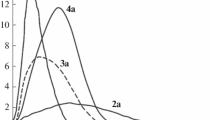Abstract
The reaction of triphenyl phosphite ozonide with various types of diazo compounds results in their oxidation, which is accomplished by singlet oxygen (1O2) evolved during thermal decomposition of the ozonide. A decrease in the ionization potential of the substrate results in an increase in the overall rate constant of quenching of1O2. In the case of 9-diazofluorene, the main channel of1O2 quenching is physical quenching.
Similar content being viewed by others
References
I. Regitz and G. Mass, inDiazo Compounds. Properties and Synthesis, Acad. Press. Inc., New York, 1986, 525.
D. Bethell and R. Keivor,J. Chem. Soc., Perkin Trans. 2, 1977, 327.
H. L. Gasal, S. E. Sugamori, and J. C. Scaino,J. Am. Chem. Soc., 1984,106, 7623.
P. D. Bartlett and C. D. Mendenhall,J. Am. Chem. Soc., 1970,92, 210.
V. V. Shereshovets, N. M. Korotaeva, Yu. I. Puzin, G. V. Leplyanin, and V. D. Komissarov,React. Kinet. Catal. Lett., 1990,42, 39.
V. V. Shereshovets, S. S. Ostakhov, N. M. Korotaeva, G. L. Sharipov, V. P. Kazakov, V. D. Komissarov, and G. A. Tolstikov,Izv. Akad. Nauk SSSR, Ser. Khim., 1989, 2687 [Bull. Acad. Sci. USSR, Div. Chem. Sci., 1989,38, 2640 (Engl. Transl.)].
A. Cominade, F. Khatib, and M. Koenig,Can. J. Chem., 1985,63, 3203.
Q. Thompson,J. Am. Chem. Soc., 1961,83, 845.
A. Weissberger, E. Proskauer, J. Riddig, and E. Tups,Organic Solvents. Physical Properties and Methods of Purification, Interscience, New York, 1955.
A. S. Vorob'ev, I. I. Furlei, Yu. Z. Ekov, A. M. Nazarov, G. A. Yamilova, U. M. Dzhemilev, and V. A. Dokichev,Izv. Akad. Nauk, Ser. Khim., 1993, 325 [Russ. Chem. Bull., 1993,42, 281 (Engl. Transl.)].
V. V. Shereshovets and N. M. Korotaeva,Izv. Akad. Nauk SSSR, Ser. Khim., 1988, 1228 [Bull. Acad. Sci. USSR, Div. Chem. Sci., 1988,37, 1078 (Engl. Transl.)].
B. Ranby and T. Rabek, inSinglet Oxygen. Reactions with Organic Compounds and Polymers, John Wiley and Sons, New York-Brisban, 1979, 61.
J. A. Barltrop and J. D. Coyle,Exited States in Organic Chemistry, Wiley, London, 1975.
T. R. Evans,J. Am. Chem. Soc., 1971,93, 2081.
Author information
Authors and Affiliations
Additional information
Translated fromIzvestiya Akademii Nauk. Seriya Khimicheskaya, No. 9, pp. 1567–1571, September, 1994.
The work was carried out with the financial support of the Russian Foundation for Basic Research (Project No. 93-03-5231).
Rights and permissions
About this article
Cite this article
Shereshovets, V.V., Korotaeva, N.M., Vorob'ev, A.S. et al. Oxidation of diazo compounds by triphenyl phosphite ozonide. Quenching of singlet oxygen by diazo compounds. Russ Chem Bull 43, 1479–1483 (1994). https://doi.org/10.1007/BF00697131
Received:
Revised:
Issue Date:
DOI: https://doi.org/10.1007/BF00697131




